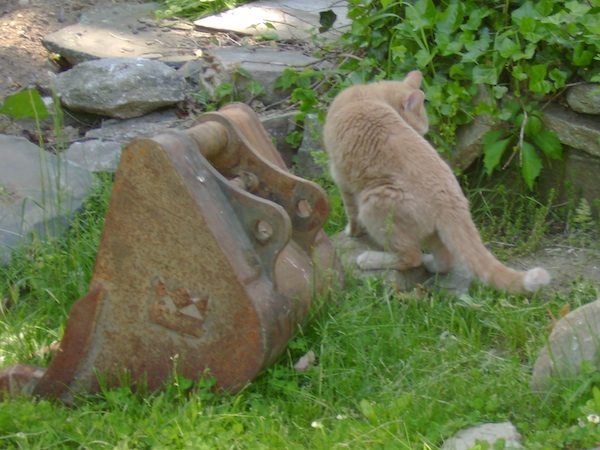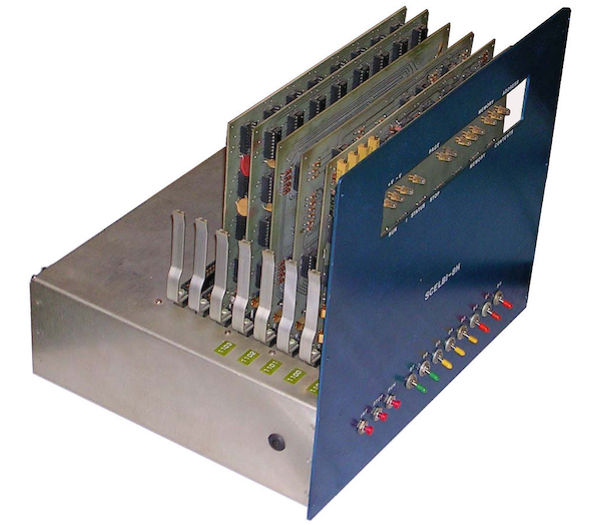This is a temporary duplicate of memorablemilford.com while we upgrade that site to a more mobile friendly version.
A search function and contact information are planned to assist anyone with information or corrections. Until then, I will post Milford history in the Facebook pages You know you live in Milford CT if.... and Milford, Ct. Then & Now

marker of Milford marble across from City Hall
Notable Milford innovations
green Milford Marble and green grass
Others elsewhere became more famous by expanding upon marketing possibilities such as advertising computers for personal use instead of the Milford innovation of advertising them as a tool for small businesses and industries. Innovators often look at things differently than average folks. When faced with obstacles several people from Milford found ways around them or pioneered new ground. Ignoring those saying things can't be done they looked for reasons to accomplish something instead of what could (however unlikely) could go wrong. They were not afraid to experiment in searching for solutions, ignoring those telling them to accept that things should stay the way they were. Perseverance towards long-term goals over quick fixes or looking forward to the weekend is not unique to Milford residents. Their driving force sometimes foregoes personal gain to help others.
Fertilizer was produced from fish on Charles Island in the 1800s. We also made straw hats and had the last earmuff company in America until foreign imports were cheaper to import. George W. Coy of Milford built the first telephone exchange that was used in New Haven in January 1878. The first photo-electric cell was installed in West Haven on June 19 1931, this was only 11 years after the town became a separate city from Milford. Items that came from Milford include grass at the 1939 New York World’s Fair grown near where the Connecticut Post Mall and a highway interchange now stand.

Milford marble mantlepiece
Public Domain photo from White House Museum
About a mile away from the seed farm location was the Milford Marble quarry. Discovered in 1811 by Yale student Solomon Baldwin, it was expensive to cut and polish high quality large blocks from the Milford marble deposit with it closing after a few years before reopening for a few more years in 1838 until the shipment of less expensive imports. In the 1930's it became the site of one of the first mobile home parks but now a shopping center parking lot. The green serpentine Verde antique marble quarried around 1825 was used on the Capitol steps in Washington DC and for several mantlepieces. A White House East Room fireplace was one of four adorned with a variety of marble representing different states that replaced the larger 2 and a half foot wide 1829 black Italian marble and the 1873 white and gold wood mantels in 1902. The different colored mantels were painted in 1961 to match and look like white marble.
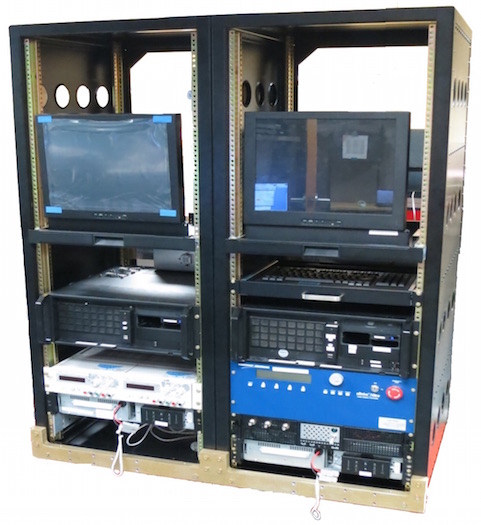
These dual equipment bays are 6 feet tall
2 SCELBI computer units fit side by side in each rack bay
only 14 rack bays with 14 SCELBIs could hold all sold
- NASA public domain photo
The first computer ad
1970's computer technology
Using computer chips in home electronics was a new idea happening at the same time in the 1970s as computers becoming small enoufgh for home use. The first home video game in 1972 could only play ping pong with a multi-game console not coming out until 1977, the same year as the Apple computer. To get a better idea of the obstacles faced in building a mid 1970's computer is that computers were limited to companies, the government and universities and what could be done with them. It had been only 5 years earlier that the government had established the ARPANET in 1969 but it was limited to between the government and schools. Computer monitors displayed computer code in green or amber text on black. Almost another decade later in January 1983, the method to exchange files on the ARPANET was changed to the Internet Protocol the same month that the first computer to have menus, windows and a mouse was introduced.
Although invented in 1963, the mouse wasn't refined into a practical device until the early 1980's. The 1st mouse prototype was a butter dish and roll-on deodorant ball. Computers were so unfamiliar that even in 1984 another computer company had to explain how to use a mouse.
A common misquote is that Al Gore invented the internet but he helped pass the legislation that made the internet as we know it available to the public in 1991.
Early websites were mostly a single column of text with few pictures.
Tim Berners-Lee of CERN, the same organization studying black holes, developed the standards for the World Wide Web in 1989. Like many idealistic innovators at the time, he gave it away for free in 1991 so more people would use it.
Unwanted spam email dates back to the days of the ARPANET and the first computer virus was created in Pakistan on January 19 1986.
A programmer created a virus as a method to prevent pirating his software but it accidentally got loose from shared floppy disks.
Like most electronic tinkerers of the day, it started as a hobby for 3 Milford men. They realized after working out the original design, it didn't take much more effort to produce many more circuit boards to sell besides the 3 computers they intended to build for personal home use. Electronics at the time were bigger and consisted of individual components such as transistors, capacitors and resistors instead of integrated circuit boards. In the 1970s, electronics generally were hand assembled with screws instead of everything being glued together allowing them to be taken apart to figure out how they were made..
Milford's SCELBI computer
In March 1974, the SCELBI company in Milford was the first to advertise a build your own computer kit that appeared in a ham radio hobbyist magazine. SCELBI stood for SCientific, ELectronic BIological. Computers at the time were room-sized machines requiring air conditioning and air filtering. A demonstration of the capabilities of a new IBM integrated circuit sparked Nat Wadsworth to realize they could be used to create a smaller and more affordable alternative to control manufacturing or test equipment. He was unsuccessful in interesting his employer in the concept so set out to build it himself along with 2 other engineers including Bob Findley. Nat Wadsworth's first heart attack slowed progress in the early stages of design development. Only 200 SCELBI units were sold fully assembled or in kits like many other electronics of that time including stereos and televisions by Heathkit. Other early computer inventors sharing ideas at the 1970 era computer clubs were inspired by similar but more versatile computers. The competing Mark-8 Altair computer, which Bill Gates wrote an operating system to run on it, came in a kit
The SCELBI's 10 inch high by 9.5 inch wide blue brushed metal finished faceplate was how some mid-1970's industrial electronics looked. It had 3 holes along each edge could be mounted with 2 units together inside a standard 19 inch equipment rack. The sides exposed the vertically mounted circuit boards plugged into the top of the main electronics enclosure. Across the front 2 horizontal rows of LED lights on a circuit board showed through a cutout in the windowless faceplate. It utilized 11 small toggle switches below them to program it. Extras available were a keyboard, an oscilloscope for use as a monitor. For memory an audio tape recorder could store programs.
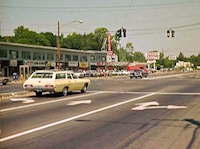
former location of SCELBI
In perspective, the SCELBI sold the same number of units as Apple's 1st computer did 2 years later. (Steve Jobs started working at Atari the month the SCELBI ad was published.) Many of the other computers that came out within the next few months of when the SCELBI was released, such as the Altair 8800, were using similar general purpose computer chips to the Intel 8008 powering the SCELBI. Wadsworth's second heart attack in May 1974, only 2 months after orders began coming in, lead him to focus on the more profitable publishing of computer manuals.
Their computer shop was located behind a deli in a small strip mall across from The Connecticut Post shopping center before operating in the Woodmont Beach area for their business of printing computer manuals.
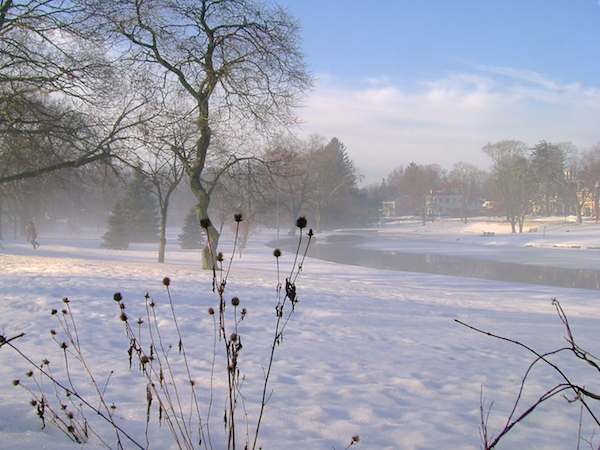
Milford's duck pond in snow and fog
The first snow making patent
The first patent for a snow making machine was issued to Art Hunt, Wayne Pierce and Dave Richey who had a successful test on March 14, 1950 in a backyard on Ford Street in Milford. A lack of snow in 1948 to ’49 led to them to try using ice rink shavings in December 1949 to try to extend the snow season so they were no longer dependent upon the weather for their aluminum/wood composite ski manufacturing company. The inventors used the last initial of their names for their company TEY manufacturing. Always coming up with new ideas on a drafting table used instead of a desk in his office, Wayne Pierce also worked on quick release skis, ski-lift equipment, ariel lift bucket trucks, developed disk brakes for the Corsair Airplane and folding wings for aircraft carrier based planes.
Within a week after the small March 1950 test their nozzles connected to tobacco irrigation sprinklers from Larchmont Farms did a larger snow producing test on Mohawk Mountain in Cornwall, Connecticut. They returned to Mohawk in October for full scale commercial production. Mohawk was only a temporary setup and other ski resorts such as Grossinger’s Catskill Resort Hotel and the Pocono’s Big Boulder and Split Rock Lodge soon had permanent installations of the amenity.
Their design consisted of a garden hose along with compressed air from a paint sprayer blowing the water into the chilly air where it froze into evenly shaped snow crystals. Adjustments were made to quiet the noise the device made that caused dogs in the area to howl and produced 3 inches of new snow per night. Early snowmaking equipment had to be manually moved to cover other areas once enough snow was produced and the hoses tended to freeze or burst.
The patent was applied for on December 14, 1950, received on April 27, 1954 and sold to the tobacco company that assisted in the Mohawk Mountain snow making. It was later transferred to the Canadian engineers led by Dr. Ray Ringer that first accidentally discovered the same snow making principle while trying to simulate and test icing on airplane wings but failed to recognize there was a market for the process. As a former aircraft-engineer, Piece, may have read the scientific journals it was published in.
Edison's engineer
Milford resident Frank Sprague was one of Connecticut’s many inventors and worked for Thomas Edison. Sprague helped create numerous improvements for the electric motor, trolleys, railways and elevators. Sprague was part of a long line of people associated with Milford exploring new ideas and lands.
Sprague started the practice of using math to solve electro-mechanical problems quicker than the trial-and-error experimentation then performed at Edison's Menlo Park Laboratory. Sprague's inventions included overhead wires for streetcars, motor improvements and the dead man's brake to stop a trolley car if the conductor lost control of it. Sprague's developments made feasible the construction of tall commercial buildings and skyscrapers.

Simon Lake's salvage tube
early submarine advances of Milford
Connecticut resident David Bushnell made an unsuccessful attempt to sink a British vessel in New York harbor during the Revolutionary War with his Turtle submarine. He tested his craft made of oak off of the coast of Milford near Charles Island on July 21, 1776 on his trip from Old Saybrook along the Connecticut shoreline. This early experiment later inspired further refinements by others including Milford resident Simon Lake.
120 years later inventor Simon Lake advanced Bushnell's submarine work of the late 1700's holding over two hundred patents. Lake's numerous firsts included the modern periscope, the first underwater telephone call in 1897 and the first submarine under polar ice.
Lake was born September 4 1866 in Pleasantville, New Jersey. The town was formerly named Lakeville after Lake's family decadents that included Abigail Adams. Growing up in a family of inventors, the red headed Simon Lake was a curious child. His friends were alarmed seeing his hand-made canvas canoe upside down only to find Lake inside trying to figure out how long one could breathe using the trapped air. Lake read books and learned what he could from engineers after quitting formal schooling at 17.
Simon Lake's initial plans for his Argonaut submarine were drawn when he was 14 and rebuilt numerous times between 1894 and 1904. Lake was presented with a congratulatory letter from Jules Verne when his Argonaut 1 submarine finished a 1000 mile journey on the open seas in late 1898.
Lake favored the submarine for peaceful operations such as salvage, exploring for oil deposits and undersea farming while emphasizing safety with double hulls. Lake had the idea for subs to pull underwater barges or tanks like an underwater train safe from storms faced by boats on the surface. They could pass under wartime blockades and their wheels could be adapted for delivering the sub where needed by rail. In 1900 the Lake Torpedo Boat Company of Bridgeport, Connecticut sought the lucrative naval market touting submarines for defense or to transport goods.
In later years, Lake diversified his submarine business for peacetime uses with prefabricated concrete houses and designed an early helicopter . He designed an airplane but in 1902 passed on having the European rights to the Wright Brothers airplane due to submarine orders by Czarist Russia.
Being a neutral country in 1904, the United States prohibited shipping armaments to countries at war. Russia and Japan were both seeking submarines. Incomplete submarines were allowed so Lake removed the batteries before shipping to Russia. The Protector remained undetected underwater and a fog helped hide the derrick loading the submarine onto a coal carrying steamship 3 miles from shore. Lake built 10 more Russian submarines but the war with Japan ended before any submarine battles.
A submarine sailing under water and aircraft in flight are similar. While in Czarist Russia, Lake reviewed flying machine drawings becoming friends with Wilbur Wright before the brother’s 1903 flight but passed on a chance to buy the European rights to their planes.
Early backers of, John Holland, Simon Lake’s main competitor for US Navy contracts were Irish separatists. The Holland Torpedo Boat Company was acquired by Electric Boat which in 1903 was secretly owned by a British company which lobbied Congress. Their monopoly on submarine construction since 1893 was broken after 1908 congressional hearings.

interior of Simon Lake's Explorer submarine
photo by Daniel Ortoleva
Lake's early submarines typically had wheels as a secondary means of travel on the ocean floor for salvage operations. In 1903 inverted toboggans on top of the Protector allowed it to skate on the underside of the polar ice.
Launched on November 1, 1902, The Protector had Lake's omniscope, the first practical periscope providing a sense of distance that could collapse when not in use.
Lake moved to Milford, Connecticut in 1907, his Lake Torpedo Boat Company in Bridgeport, Connecticut set a depth record with Lake's first U.S. Navy submarine, in November 1912. Prior to France building the first diesel submarine in 1904, submarines using electric motors, steam engines and gasoline were underpowered or uncomfortably hot. Lake switched to designing maritime salvage systems when post World War I international treaties limited the size of navies in 1922. He obtained salvage permission for the Lusitania and a Revolutionary War era British frigate with his submarine, the Explorer. During World War II he was a United States Navy submarine and salvage advisor.
On July 8 1916, while the United States was still a neutral country, Simon Lake tried to confiscate a German sub that was based upon one of his patents. It had docked in Baltimore to transport goods through the British blockade. The Captain claimed to Lake that it only held humanitarian goods. Simon Lake spent seven thousand dollars, equivalent to $165,500 in 2016, warning German submarines targeting passenger ships like the Lusitania because "War consists almost entirely of killing and destruction". "We are a cheerful people, and we refuse to believe what we do not want to believe."
By 1911 the Lake Boat Company was the only company specializing exclusively in building submarines. A decade later post World War I treaties limiting navies dried up the submarine market. He closed the submarine plant in 1922 to focus on other industries. Originally conceived of in 1901, Lake’s "salvage tube" was built for the first attempt to recover the Lusitania in 1935. Divers could to take stairs down to the ocean floor to an air lock to quickly switch with a returning diver. Lake had designed an early helicopter and contacted Igor Sikorsky about using his prefabricated concrete homes for his workers and returning servicemen. A factor in poor sales for Lake's "Sunshine Homes" was resistance by labor over being promoted as requiring less skilled workers.
Lake was a teetotaler and the christening of Lake's Nautilus during Prohibition on March 24, 1931 was not with champagne but with an ice bucket. This substitution was appropriate for sailing under 37 feet of polar ice to within 600 miles of the North Pole.
Built in 1933, Lake's last small salvage sub, The Explorer, originally named "The Crab", went on display by the Milford harbor in 1998. It is actually a combination "pocket" sub and salvage tube. The remains of one of Lake"s salvage tubes like the one built to explore the Lusitania for is about 1/2 mile due south near the mouth of the Milford Harbor. (Interior shown in inset photo.)
Simon Lake's work has been recognized by US Navy with submarine tenders between 1964 and 1999 bearing his name. A Milford grammar school named in his honor closed in June 2010. In popular culture the sub sandwich is named for resembling a submarine. 2 of the first 10 locations for the Subway sandwich shop company headquartered in Milford selling 79¢ sandwiches were in Milford. 2 weeks after the company's 50th anniversary on September 14, 2015, their founder Fred DeLuca died.
Simon Lake stated "I had rather die broke because I had been spending my money in doing worthwhile things than sitting around cutting coupons." "I quit this foolishness about retiring, went back to work, lost all my money, and have been quite happy."
In 1937 Lake insisted on repaying back his creditors after declaring bankruptcy by selling many prized possessions. Simon Lake moved into a smaller house 2 doors from his home on the green bought by to a funeral parlor. He died on June 23 1945.

Northwest map based upon explorations by Peter Pond from Milford Connecticut
- LOC public domain photo
Northwest Exploration of the Canadian tar sands
Peter Pond, born in Milford on January 18, 1740, is more well known in the Canadian region he first explored in the 1780s & as founding the North West Company than his birthplace. The Hudson's Bay Company ultimately acquired Pond’s fur trading company. Pond founded several cities in Alberta, Canada including Fort Chipewyan and Fort McMurray.
After serving in the French and Indian War, Pond head north along the Mississippi River to open between 1776–1778 a fur post about 500 miles north of Montana. Pond explored waterways and drew maps of Hudson Bay region including the source of the thick tar commonly referred to as the Canadian tar sands. Despite Pond’s maps of the territory, there are few accounts of Pond’s descriptions of the area explored due to there are no diary entries after 1775. Peter Pond was the first to explore and map vast stretches of North American and blazed trails that were used for 100 years until trains could reach the area.
Pond being a large man with a temper resulted in numerous stories of shooting men which led to his removal from his post in 1788. He taught his successor, Alexander Mackenzie, about the land and which local Indian tribes to trade with or to avoid. Mackenzie continued Pond’s explorations becoming the first to see the Pacific Ocean paving the way for Lewis and Clark. Pond returned to Milford, Connecticut, where he died in poverty and was buried in an unmarked grave on March 6, 1807.
For more about Peter Pond please visit the Peter Pond Society.
